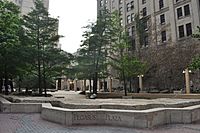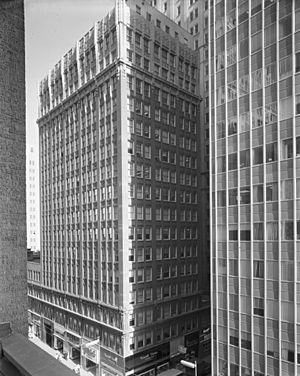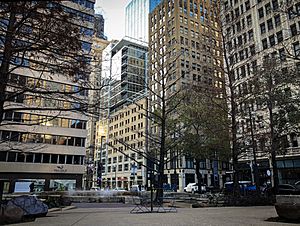Pegasus Plaza facts for kids
Quick facts for kids Pegasus Plaza |
|
|---|---|
 |
|
| Type | public plaza |
| Location | Dallas, Texas |
| Area | 16,000 sq ft (1,500 m2) |
| Created | 1994 |
| Operated by | City of Dallas |
| Status | open all year |
Pegasus Plaza is a cool public park located in downtown Dallas, Texas. You can find it where Akard and Main Street meet in the Main Street District. The plaza is named after Pegasus, the famous flying horse sign on top of the nearby Magnolia Hotel. This shady plaza has several fountains and is a popular spot for concerts, festivals, and Christmas celebrations.
History of Pegasus Plaza
Pegasus Plaza was built as a main part of a big project to fix up the historic Main Street District. This project cost $7 million. The goal was to make Main Street look new again with better lights, plants, and street furniture. This was done to help bring new life to many old buildings in Dallas.
The plaza itself cost $2.5 million. Money for it came from a 1982 bond election ($750,000) and private donations. Famous actress Greer Garson gave $500,000 to help create the plaza.
The plaza was built on a corner parking lot. Before that, the Southwestern Life Insurance Building stood there from 1912 until it was torn down in 1972. Work on the 16,000-square-foot (1,500 m2) plaza began in 1993. It officially opened in September 1994. Dallas Mayor Steve Bartlett and former Mayor Annette Strauss were there for the opening.
Since it opened, Pegasus Plaza has hosted many city parties. This includes the city's big millennium celebration in 2000. That event featured fireworks and the relighting of the restored Pegasus sign on the Magnolia Building.
Design and Features of the Plaza
Many architects and engineers worked together to design the Main Street project. The design of Pegasus Plaza itself was created by artist Brad Goldberg. Even though the plaza is near the 50-year-old neon Pegasus sign, its design is deeply inspired by ancient Greek stories.
The plaza's design tells a part of a Greek myth. It's about the warrior Perseus who defeated the monster Medusa, who had snakes for hair. From Medusa's head, the winged horse Pegasus was born. The story says Pegasus then stomped his hoof on the ground, creating the Fountain of the Muses.
A beautiful limestone fountain and a winding stream are central to the plaza's design. The fountain gets its water from a natural mineral spring. This spring is located 1,600 feet (490 m) below the Magnolia Building. Circles are carved into the pavement around the fountain. These circles spread out into the nearby streets.
You will find nine large granite boulders placed around the plaza. These stones came from Marble Falls. Each one is carved and dedicated to one of the nine Muses from Greek mythology. For example, a stone for Terpsichore, the Muse of dance, is next to a performance area. Another stone for Melpomene, the Muse of sad songs and plays, is near a group of willow trees. Willows are sometimes a symbol of sadness. The plaza also has a 4,000-pound quartz crystal and a group of bald cypress trees. These elements are meant to represent healing and nature.



